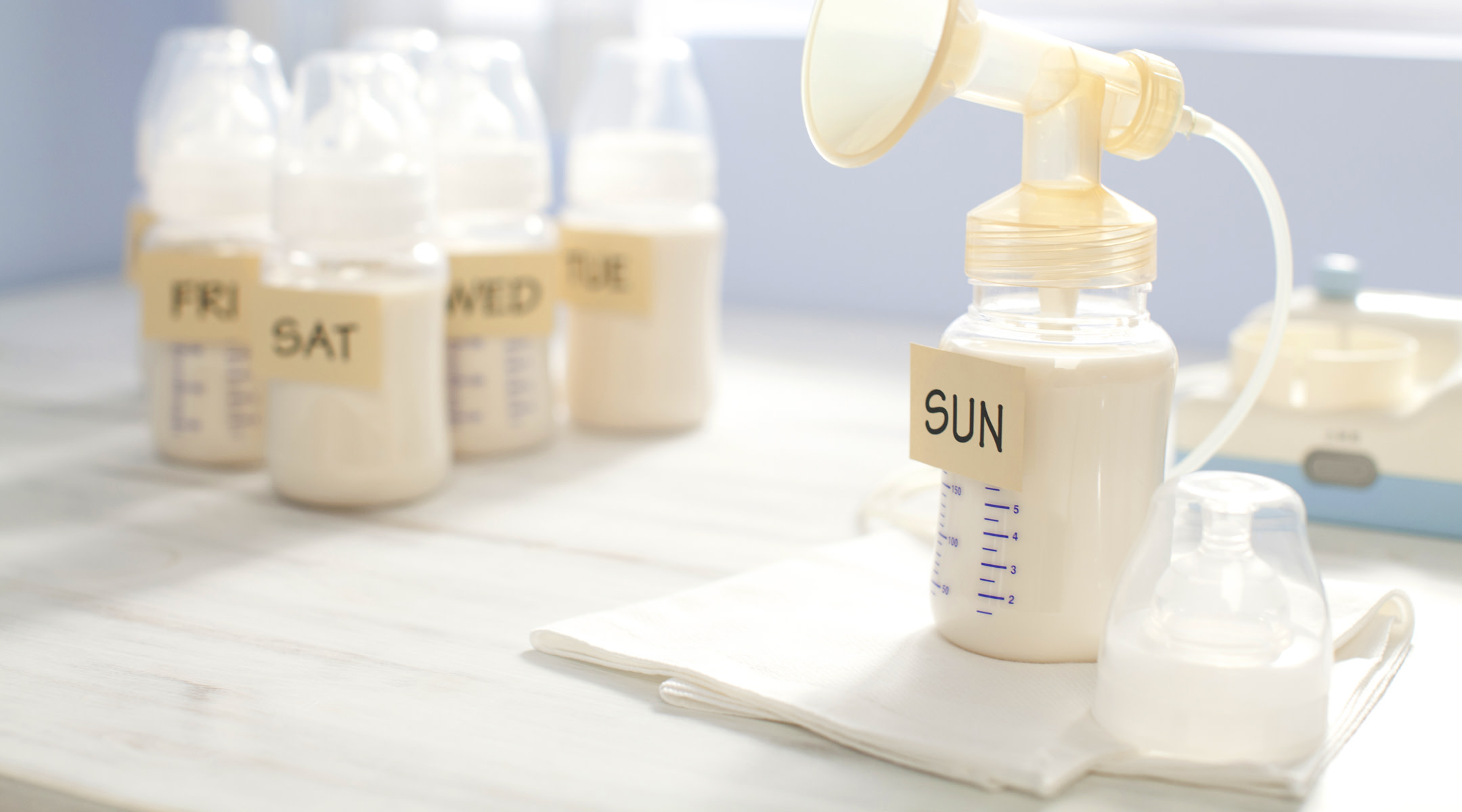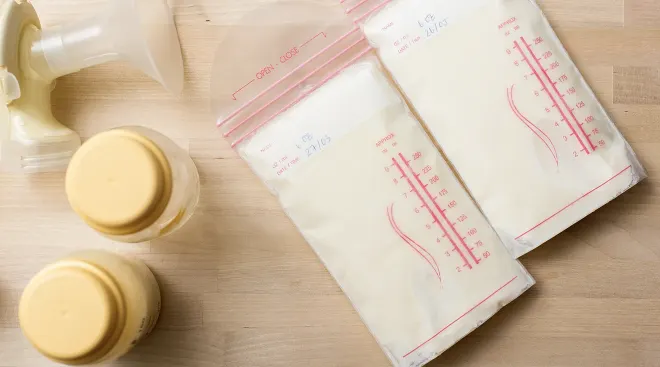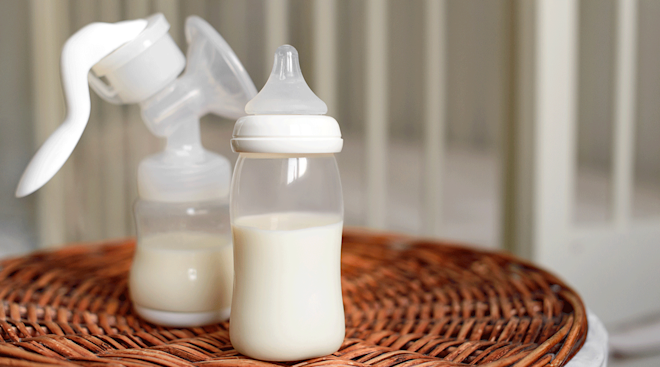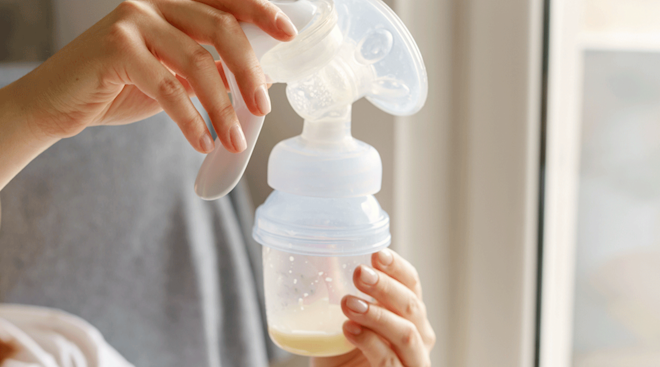Tips for Starting a Breast Milk Stash Before Returning to Work
Nursing your newborn is an all-day, ongoing affair, so the thought of providing enough breast milk once you head back to work can be daunting. Add to that the onslaught of Instagram images showing moms’ freezers bursting with frozen breast milk, and you can’t help but wonder how you’ll ever build an adequate breast milk stash. Don’t worry! Lactation consultants say that with efficient planning and the right pumping strategy, you’ll have plenty to keep your new baby fed. Here’s how to go about starting a breast milk stash and when to start pumping for storage before returning to work.
On your first day back to work, you’ll likely pump enough to fill baby’s bottles for the next day—but having some breast milk already stashed in the freezer will provide peace of mind. Otherwise, “it’s going to be really stressful,” says Freda Rosenfeld, an International Board Certified Lactation Consultant (IBCLC) and certified childbirth educator in New York City—especially as you’re settling into a new routine. Your breast milk stash gives you more “wiggle room” if pumping doesn’t go as planned.
It happens—you forget the pumped milk in the office fridge, you end up with back-to-back meetings and no time to pump, or you find that your once-robust supply suddenly drops (which is not uncommon when you head back to work). With a good supply at home, you can just ask your caregiver to defrost a few ounces, no matter what’s thrown at you. “It allows you to feel less anxious about keeping up with baby’s needs," says Ayelet Kaznelson, an International Board Certified Lactation Consultant (IBCLC) and labor support doula in New York City.
One of the biggest questions on new moms’ minds is when to start pumping breast milk before returning to work. But here’s the thing: The best time to begin pumping is as individual as each mom’s post-partum life. “It depends on the timing of your return and what else is going on with breastfeeding,” says Kaznelson. If you’re still working on getting comfortable with breastfeeding, bonding or other important issues, then don’t feel bad about putting pumping on the back burner.
She also emphasizes that a woman’s personality may dictate timing. “Some women are planners and they want to get going on it; others don’t want to think about work and just need the time to hang out with their baby,” she says. Either way, working with a lactation consultant or even getting support from a local breastfeeding support circle can help you figure out a timetable that works for you.
Assuming you have several weeks of maternity leave (not all women do) and breastfeeding is going smoothly, a good window is about three weeks before your start date—”that’s all [new moms] really should need,” says Rosenfeld. Don’t worry about it before then; instead, focus on enjoying your time at home with baby.
It may seem like an insurmountable task to stockpile enough breast milk for your growing child each and every day of the work week. But it’s not as formidable as you think. Whether your milk flows easily or collecting it feels like painstaking work, small and steady is key to a big return. Here, some top tips on how to go about starting a breast milk stash:
• Estimate how much baby will consume during your workday. According to the American Academy of Pediatrics (AAP), babies between age 2 and 5 months can take anywhere from 4 to 6 ounces each feeding, every three to four hours. Six-month-olds might drink as much as 8 ounces each session, although they can sometimes go five hours between feedings. Remember that every baby is different—some may take smaller portions but feed frequently, while others may eat more but across fewer sessions.
• Introduce the bottle when baby is between 4 and 6 weeks old. Aim for about five times a week, says Kaznelson. See how comfortable baby feels with it and how much they might consume from it each session. Have your partner, friend or potential caregiver give the bottle so you can pump at the same time. Try to relax and watch TV or do something else that’s fun at the same time. “Reward yourself for working so hard,” says Kaznelson.
• Pump three times daily, but only after you feed baby. This way, baby consumes as much as they want, and you take only what’s left behind.
• Pump at the same time each day. Consistency will encourage your body to make more milk, as it starts to learn, ‘Oh, it’s a double helping,’ " says Rosenfeld. This also helps prevent clogged ducts, which can lead to a mastitis infection. And of course, a routine provides a sense of security, which is nice when just about everything in your new-mom life seems frenetic and unpredictable.
• Pump right after the first morning feed. Many women find that they get the most milk at this time of day, so make it one of your three daily sessions.
• Massage your breasts before you pump. This helps stimulate your milk glands so the milk flows more easily.
• Aim to pump for 8 to 12 minutes per session. Longer is not necessarily better. “It can be exhausting," says Rosenfeld. Since you’re essentially collecting leftover milk, you probably won’t get more than 1 or 2 ounces each time—and that’s okay. Just small increments on a daily basis add up to quite a bit, says Kaznelson.
• Stash three to four days worth of milk before your start date. You don’t need more than this because you’ll continue to build your breast milk stash at work. As Kaznelson explains, the fresher the milk, the more preferable it is. That’s because breast milk is filled with disease-fighting antibodies. “It’s not that a 6-month-old can’t drink the milk you pumped three months ago, but current milk has antibodies to whatever is going on around at the time, so baby is getting that constant protection,” she says. According to the Centers for Disease Control (CDC), it’s best to use the milk within six months, though it’s fine to store it for up to a year.
• Go easy on yourself. Even if you decide to supplement with formula, it doesn’t need to be the end of nursing or pumping. "It’s not all or nothing,” says Kaznelson. Some women just nurse in the mornings, evenings and on weekends, and they (and their babies) still get a lot out of it. Discuss your concerns and challenges with a lactation consultant, and she can help you come up with a plan.
By the time you return to work—depending on baby’s age and the number of feeding sessions you’re compensating for—you might have anywhere between 36 and 72 ounces set aside. (Babies born prematurely or with other health issues may have different requirements.) Protect your precious breast milk stash with these strategies:
• Chill fresh milk before combining with refrigerated milk. It’s safe to blend together milk from different pumping sessions—for instance, to create a single 3-ounce frozen bag from three 1-ounce portions. Just make sure to chill the fresh milk for a few hours before adding it to what’s already in the refrigerator. Otherwise, adding just-pumped milk to refrigerated milk will decrease the colder milk’s temperature and cause it to thaw.
• Gently swirl your milk around. This keeps the fat from separating and giving the milk a funny odor when it’s defrosted. Don’t shake.
• Freeze pumped milk within 24 hours. Freezing right away to help maintain its nutrients.
• Vary your portion amounts. Breast milk can’t be refrozen once it’s defrosted. So to avoid waste, don’t freeze anything larger than a 4-ounce bag or bottle. And don’t forget to include a few 1- or 2-ounce portions. These come in handy when, say, baby is going through a growth spurt. “Your caregiver can add those as needed without defrosting a full bag," says Kaznelson.
• Leave a little room in the storage bag. Breast milk expands as it freezes. To keep plastic storage bags from bursting, fill them only to about three-quarters full and squeeze out the air before you seal it.
• Never store breast milk in the freezer door compartments. The constant opening and closing of the freezer door may cause the milk to thaw slightly. The back of the freezer is the ideal storage spot, since it tends to have the coldest and most consistent temperature.
• Monitor the freezer temperature. If your freezer doesn’t automatically display the temperature, use a separate thermometer to monitor it. “The freezer might always seem cold, but think about the difference between a 20-degree day and a 0-degree day,” Rosenfeld says.
• Use the oldest milk first. As Rosenfeld says, “A good grocer always rotates the stock.” Whether you choose plastic bags made especially for breast milk (organized either inside larger Ziploc bags or a storage caddy) or a set of bottles, label each portion with the date you pumped it and how many ounces it contains. To make it easy for caregivers, put the oldest milk in the front and the most recent at the back.
Updated February 2020
Expert bios:
Freda Rosenfeld, IBCLC, is an International Board Certified Lactation Consultant and certified childbirth educator in New York City. She has been in private practice for almost 30 years and sees about 500 nursing mothers annually throughout the New York metro area.
Ayelet Kaznelson, IBCLC, is an International Board Certified Lactation Consultant and labor support doula in New York City. For nearly two decades, she has worked with more than 10,000 women and babies in her private practice as a lactation consultant. She currently runs clinics and classes related to breastfeeding and newborn care at the Prenatal Yoga Center and The Motherhood Center, and lives with her husband and two children in Manhattan.
Please note: The Bump and the materials and information it contains are not intended to, and do not constitute, medical or other health advice or diagnosis and should not be used as such. You should always consult with a qualified physician or health professional about your specific circumstances.
Plus, more from The Bump:
Navigate forward to interact with the calendar and select a date. Press the question mark key to get the keyboard shortcuts for changing dates.




















































